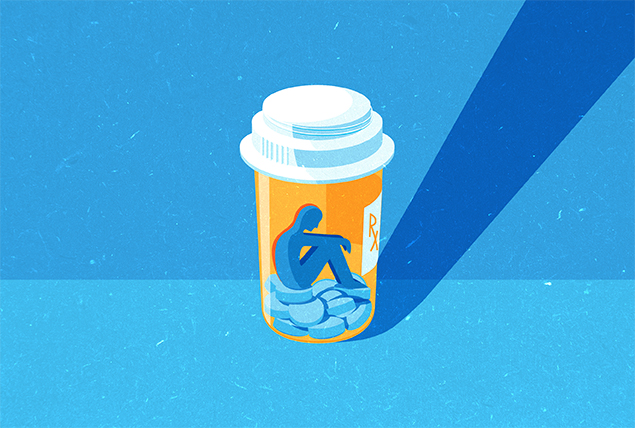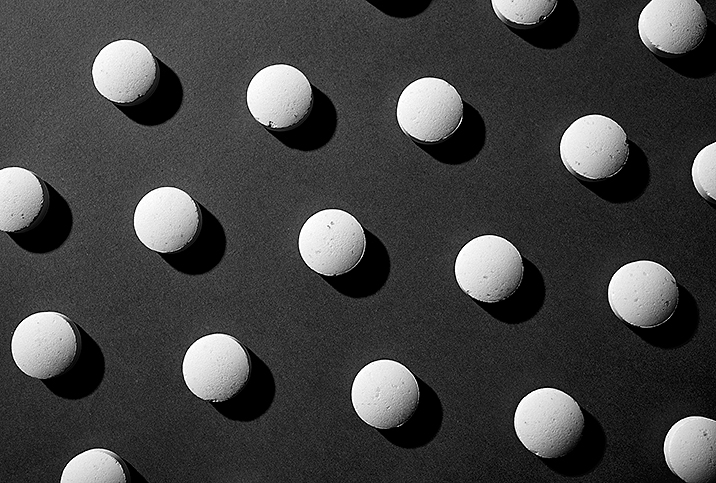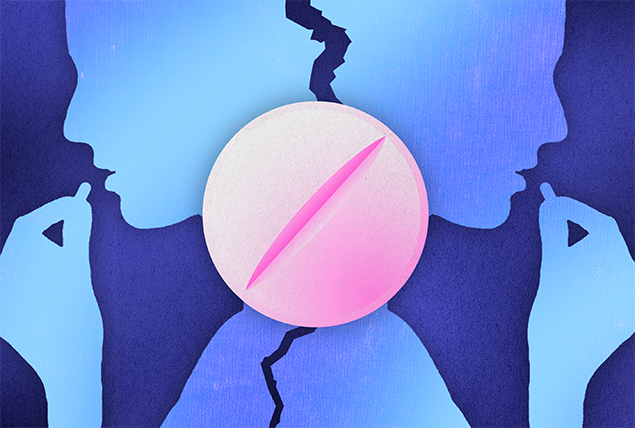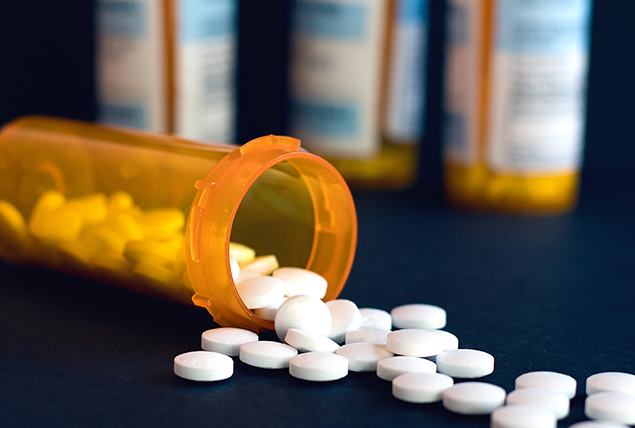Explaining Opioid Use Disorder Treatment Guidelines

Opioids are a class of highly addictive drugs that act on opioid receptors in the brain and body to diminish pain and induce relaxation and euphoria. They include illegal substances such as heroin and prescription medications such as oxycodone, hydrocodone, codeine and morphine.
About 10 percent of people who take opioids become addicted, per the Mayo Clinic. More than 3 million people in the United States have opioid use disorder (OUD), according to the National Library of Medicine.
Opioid use disorder, or addiction, can profoundly diminish a person's health and well-being.
"Opioid use disorder is a serious condition that can have significant negative effects on an individual's health, relationships and overall quality of life," said Dung Trinh, M.D., the chief medical officer at Healthy Brain Clinic in Long Beach, California.
In terms of sexual and reproductive health, opioid use disorder can interfere with hormones such as testosterone, estrogen and progesterone that influence libido, erectile function and ovulation.
Research indicates opioid use, even in the short term, is linked to a substantial decrease in libido and an increase in sexual dysfunction, including erectile dysfunction. Opioid use can also disrupt menstruation, diminish fertility and raise the risk of pregnancy complications.
Opioid misuse and addiction can also be deadly. In 2021, more than 80,400 people in the U.S. died from complications of the disorder, according to the National Institute on Drug Abuse (NIDA).
Recognizing the signs of an opioid use problem is the first step in reducing the risk of harm and starting recovery. With medical intervention and sustained treatment, it is possible to overcome opioid use disorder.
When to seek help for opioid use disorder
In the simplest terms, a person might have an opioid problem if they are using the drug outside the parameters of their doctor's prescription, said Olalekan Otulana, M.B.Ch.B., a general practitioner and addiction specialist in Stevenage, United Kingdom.
"Opioid use disorder is also called addiction. This means the person has a physical dependence on an opioid and a loss of control over their use of it," said Jennifer Lee, M.D., a chronic pain management specialist at Acute Pain Therapies in Kenmore, Washington. "This can be seen as taking greater quantities than are prescribed, using opioids to relieve withdrawal symptoms, devoting a lot of time to getting and using the medicine, and inability to stop the medicine when he or she wants to."
A common indicator that a problem could be developing is a strong urge to take the drug even when not instructed to do so or to take opioids from people who have been prescribed them, Otulana said.
Additional signs include using more opioids than prescribed or intended, continuing to use opioids despite adverse consequences, withdrawal symptoms when not using opioids, and a diminished capacity to fulfill responsibilities at home, school or work, Trinh said. Other potential signs include changes in mood or behavior, social withdrawal, and neglecting personal hygiene or appearance.
People should seek treatment as soon as possible, ideally at the first signs of a problem, according to Maeve O'Neill, the executive vice president of Addiction and Recovery at All Sober in the Dallas-Fort Worth area. Everyone's experience is unique, so those signs may vary from one person to another.
"Seeking professional help from a healthcare provider or addiction specialist can provide guidance and support for recovery, which may include medication-assisted treatment, counseling and other therapies," Trinh said.
Someone with a substance use issue has a better chance of successful recovery and avoiding potential complications associated with long-term opioid use if they seek help as soon as possible.
Even if you aren't sure if you have a problem, it is best to err on the side of caution and speak with a doctor or an addiction specialist. As with many health conditions, treatment and recovery are generally less challenging in the beginning phases of the disorder. However, experts stressed it is never too late to seek support.
"One important thing to remember is that it is never the wrong time to get help," said Peter Vernig, Ph.D., the vice president of Mental Health Services at Recovery Centers of America in Philadelphia.
Opioid use disorder treatment options
Opioid use disorder treatment is generally multifaceted. It includes a combination of medication, counseling and behavioral therapy, and support groups, Trinh said.
Medication is the most crucial component of these, as behavioral and talk therapies alone will not suffice, said Libby Jones, the project director at The Overdose Prevention Initiative in Washington, D.C.
"Medication for opioid use disorder (MOUD), such as buprenorphine or methadone, is the gold standard for treatment," Jones said. "Evidence-based treatment significantly reduces the risk of overdose death. People with opioid use disorder are far less likely to die from an overdose when they receive MOUD than when they do not."
Trinh explained that medication-assisted treatment, which can also include naltrexone, can help to manage withdrawal symptoms and reduce cravings by rectifying neurological dysfunctions that can both contribute to and result from addiction.
"The effectiveness of treatment for opioid use disorder varies depending on the individual and the type of treatment received," Trinh said. "However, research has shown that medication-assisted treatment (MAT) can be highly effective in reducing opioid use and improving outcomes for individuals with opioid addiction.
MAT, she added, has been shown to reduce the risk of overdose and improve retention in treatment compared to approaches that don't use medication.
Used alongside medication-assisted treatment, counseling and behavioral therapies can help people develop coping skills and address underlying issues that might have contributed to opioid use disorder development and maintenance, Trinh said. Meanwhile, support groups can provide a sense of community and accountability.
If a person is actively withdrawing from opioids, detoxification treatment ("detox") may also be necessary, Vernig said. Detox typically lasts four to seven days, though for some people it can take longer. During this period, the person is medically monitored as the drug leaves their system.
Healthcare providers may administer medications to ease discomfort, which can be intense and involve symptoms such as diarrhea, nausea, vomiting, muscle aches and anxiety.
"If you or a loved one are worried about withdrawal, getting help from the medical professionals in a treatment program can help," Vernig said. "Withdrawal can be treated with medication and staff can help make this process less difficult and scary.
"What is most important is that treatment doesn't end when withdrawal does. People struggling with opioid use often need longer-term treatment, including inpatient and outpatient care, to stay in recovery long-term."
The recovery process is highly variable from one person to another and dependent on factors such as the type of opioids a person was taking and their condition's severity.
"It's important to work with a healthcare provider or addiction specialist to determine the best course of treatment based on individual needs and circumstances," Trinh said, adding that recovery is a lifelong process, and ongoing support and care are often necessary. "The opioid use recovery process can be challenging and complex, but it is possible with the right support and treatment."
Choosing between outpatient and inpatient OUD treatment
Outpatient and inpatient treatment work very similarly, according to the Hazelden Betty Ford Foundation, with both typically incorporating a multifaceted approach of medication, individual therapy (such as CBT) and group meetings. The primary difference is that the latter involves 24/7 on-site support and monitoring at a designated facility, along with an initial supervised detoxification period. Conversely, outpatient treatment entails attending meetings and appointments while staying at home.
The decision to select inpatient or outpatient care depends on several factors, including the addiction severity, mental and physical healthcare needs, and personal circumstances. Sometimes, people choose outpatient care because an inpatient program would interfere with obligations and responsibilities such as childcare or work.
Generally, our sources said people with severe addiction or co-occurring conditions can benefit most from inpatient care. Outpatient care may be appropriate for people with less severe addiction, a safe and supportive home environment, and the resources to attend regular appointments.
"If someone has tried and is repeatedly unable to stop use of opioids on their own despite a strong desire to, inpatient treatment may be best," Lee said. "Additionally, if someone is on very high doses or a combination of several medicines that create dependency, inpatient care to transition off those medicines may be best.
"The inpatient setting can control withdrawal symptoms and provide a safe, supportive environment for the transition."
Experts said people sometimes transition from one kind of care to another at different phases in their recovery. For example, O'Neill said, many people follow up residential treatment with a sober living home to solidify their recovery while they attend other forms of outpatient treatment, including support group meetings and medical checkups.
Ultimately, Trinh said, the decision should be made in consultation with a healthcare professional who can assess the person's particular needs and provide a recommendation in kind.
What is OUD inpatient treatment like?
Inpatient treatment can occur in a hospital or residential treatment center. With this kind of care, patients live on-site with others with substance use disorders. In such settings, patients receive meals, a bed and access to resources to support their sobriety and recovery, including medical care, medication, individual therapy and support groups.
Inpatient programs also provide medically managed detox programs to help people safely manage withdrawal.
"Among the most effective treatments for opioid misuse is residential rehab," Otulana said. "This is due to the fact that during the stay there is the seclusion from outside temptations, medication to detox and therapy to guide you through the withdrawals."
What is OUD outpatient treatment like?
Per the Hazelden Betty Ford Foundation, there are three main types of outpatient treatment. These represent a continuum of care designed to serve different needs. Some people start in the most intense level of treatment and transition to a less intensive program as their recovery progresses.
The program types are high-intensity outpatient treatment, intensive outpatient treatment and low-intensity outpatient treatment.
High-intensity outpatient treatment
Also called partial hospitalization or day treatment, this involves meeting with treatment providers five to seven days a week for up to six hours a day. Such programs can help to address co-occurring medical problems along with addiction.
Intensive outpatient treatment
These programs involve group and individual sessions, with appointments three to four days a week. Many providers offer specialty programs for different demographics, including female-identifying, male-identifying and LGBTQIA+ people. High-intensity and intensive outpatient programs that involve at least nine hours of treatment per week are as effective as inpatient programs for most people, according to a review published in Psychiatric Services.
Low-intensity outpatient treatment
People who have sufficient stability and resources might consider a program with weekly group meetings and monthly individual appointments.
Outpatient treatment disrupts daily life less than the other options. This model has been used a lot since the COVID-19 pandemic in a virtual setting, which is more manageable for most people, according to Jaime Bridges, L.C.S.W., Director of Opioid Substance Use Disorders at Orlando Health in Florida.
"This requires less time commitment by eliminating travel or the requirement for a vehicle or a valid driver's license," Bridges said. "These are common barriers for people suffering from opioid use disorder."
Opioid use disorder therapies
Research indicates therapy can be a beneficial component of opioid use disorder treatment when used in conjunction with medication. Of the many kinds of therapy, cognitive behavioral therapy (CBT) is the most used in substance use disorder treatment. CBT aims to help people recognize and change negative thinking patterns and adopt helpful coping strategies, according to the American Psychological Association (APA). Some people with opioid use disorder may also benefit from talk therapy.
"The goal of therapy is to eliminate using mind-altering substances while learning to live life on life's terms," Bridges said. "Changing behaviors, creating positive belief systems, improving thought processes and learning healthy coping skills are key areas targeted in therapy."
Other facets that are imperative to the recovery process include:
- Accountability
- Accepting things we cannot change
- Learning to accept help
"Opioid use disorder is a lifelong disease," Bridges added. "The goal of therapy is to teach each individual a more positive approach to the day-to-day battles in the hope [of winning] the war against opioids."
12-step programs for OUD
Alcoholics Anonymous designed the 12-step model, which is now used in the treatment of various substance use disorders. Like CBT, talk therapy and support groups, 12-step programs are not a standalone treatment for OUD but can be a beneficial complement for some people.
Bridges explained that the first three steps require a person to acknowledge that they have become "powerless" against their disorder and to accept help from a higher power. Importantly, the "higher power" does not have to be religious. Another key component, Bridges said, is that recovery is impossible alone. For that reason, working with a sponsor and attending meetings are key.
"As the person works the steps, they must acknowledge their shortcomings and make amends to those they have wronged while in active addiction," Bridges said. "This allows for ownership and responsibility to be recognized. This also gives loved ones the opportunity to trust again. It is important to recognize the trauma and the events that led to active addiction."
The steps in the program allow the trauma to be processed and addressed before the person in recovery can move to a healthier way of living, he added.
"The last few steps require forgiveness of oneself, regular connection with a person's spirituality and continuing to do service work," Bridges said. "The steps are a lifelong commitment. It is a way of life for a person in recovery."
Everyone does not recover the same. Recovery looks different for everyone.
"It is important to allow for a person to have a choice in their recovery and how they recover," Bridges said. "All of these different elements will need to be in the recovery process while allowing the person in recovery to be the driving force."


















